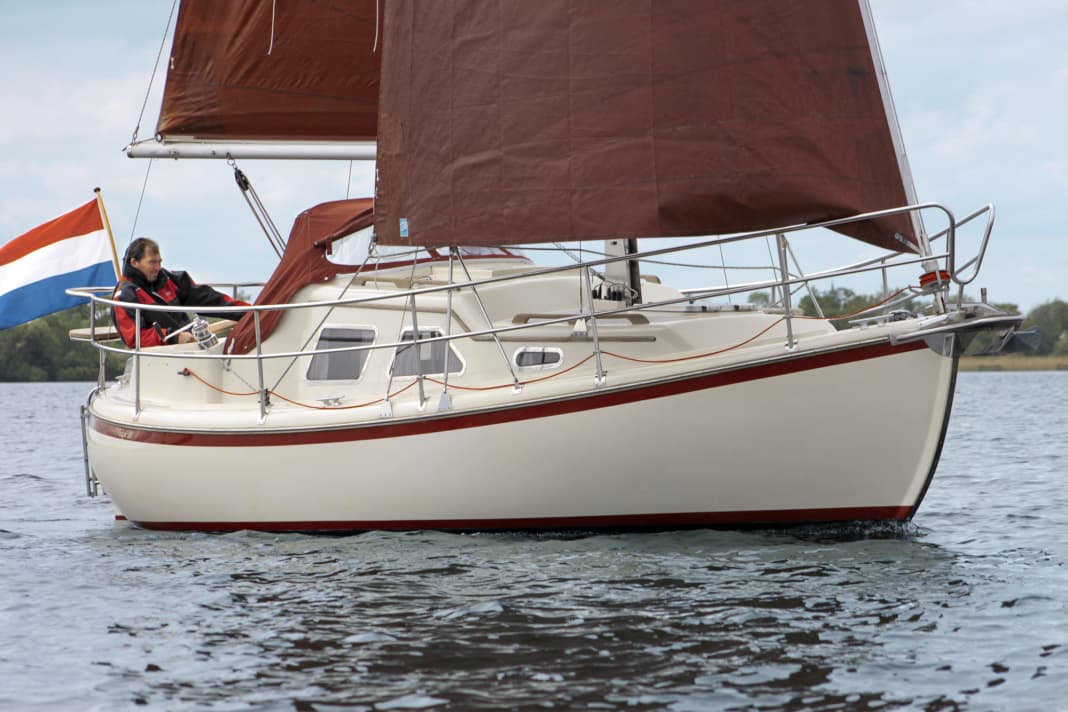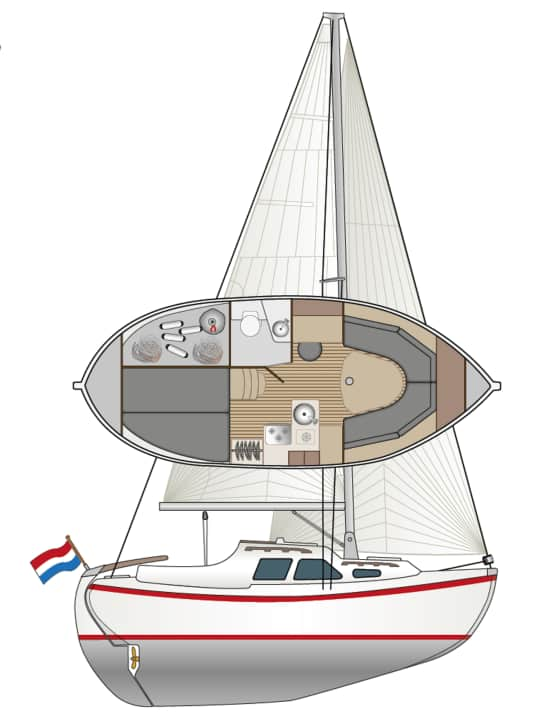





They exist, these designs that polarise - that you either love or completely reject. The Vespa is one of them. Or the VW Beetle, successful, sold thousands of times and with a loyal following. But also with opponents who never tire of pointing out the product's weaknesses.
The Midget 26 is another such design. Unlike the Beetle and Vespa, it was only built around 200 times, but it was polarising. A pointed gate, long keel, attached rudder and somehow cuddly; but not exactly spacious inside. However, its seaworthiness is legendary: several circumnavigations of the world with this type are proof of this.
More used boat tests:
- Dufour 365 GL: Unconventional large series boat in a used boat test
- Bavaria 30 Plus: Used boat test of the pocket-sized family yacht
- Lagoon 410: What can the pioneer of large series catamarans do?
- Oceanis 361 as a used boat: Solid cruising yacht from the large series
- Used boat test: Sirius 31 - the designer's last dream
The manufacturing quality is just as legendary. Weighing around three and a half tonnes, the length speaks for solid construction or over-cautious calculation. The hull and deck are laminated together, so the technology and interior have to fit through the companionway. 41 per cent ballast ensures stability. Another example of the solid construction are the surrounds of the swallow's nests in the cockpit: they were milled from a whole teak panel at the time, so there are no seams, which results in longevity. However, the offcuts would make controllers in modern shipyards break out in a sweat.
The Midget 26 is stable, solid, slow
Another example is given by shipyard boss Martin de Kloet himself: "We fit the windows with silicone. This is simply the best sealant in the long term. The gelcoat is of exceptional quality and sufficiently thick. So it never needs to be painted." Hopefully he is right, because paint does not adhere to surfaces to which the sealant has been applied.
The test boat from 2001 spent around 15 years in the Mediterranean. UV and salt water were unable to cause any permanent damage to the gelcoat during this time. In this respect, the chances are good that a paint job will not be necessary for the time being. Multiplex panels were inserted into the hull and deck in areas subject to high loads. The deck is partly made as a sandwich with closed-cell foam. The polyester water tank is permanently laminated in and does not have an inspection hatch. The diesel tank also lacks one, but it is made of stainless steel and can be removed from the ship.
When you step on board, you notice the enormous stability. No wonder: almost three metres wide with a length of 8.35 metres provides a lot of initial stability. The large amount of ballast also helps to create a feeling of safety on board. Of course, the wide gangways and high cockpit coaming also contribute to this. The boat therefore exudes solidity and safety.
Midget is like a VW Beetle: it can be better
Roughly like the Beetle. Unfortunately, there is another similarity: like the rear-engined Porsche design, the Midget is not particularly lively. Not to say: slow. With jib and main, she has a sail area of just 23 square metres. Considering the weight, that's not enough. The sail load factor of 3.2 is almost unbelievably low. Added to this is the large wetted area of the long keel, which leads to rather unpleasant results under sail.
On the test day, the wind was blowing at 10 to 12 knots and the boat was tacking at just over 100 degrees over the ground. The speeds are not breathtaking either. Nevertheless, there is light rudder pressure. You can feel the gusts in the long tiller.
Tacking is easy even without engine assistance. In high winds and waves, the boat will undoubtedly show its strengths; protected from spray in the deep cockpit with the confident sea behaviour typical of a long keel, even 6 and more Beaufort are no problem. In light winds, however, the Midget is under-rigged. Even the larger genoa won't help much. Here, too, the sail carrying capacity reaches just 3.6 and is still worlds away from modern designs. For comparison: even a Contest 29 achieves a figure of 4.1 with a large genoa.
But that doesn't bother Midget fans. It is important to them that they are sailing a fully-fledged yacht that is not yet nine metres long and that not everyone has. And that even high winds and rough seas don't put the ship or crew in trouble. The clearance height of just eleven metres is also a weighty argument in the Netherlands.
Aisleless and complete inside
A fully-fledged boat really is waiting below deck. The galley, spacious, easy-to-use toilet room, a navigation table and a separate aft cabin are major plus points. The large seating area at the front can also be converted into a berth. This is then 1.90 by 1.90 metres in size and therefore quite spacious. The headroom below deck is 1.85 metres at the companionway and 1.60 metres forward in the cabin. The aft cabin offers a berth measuring 1.80 by 1.60 metres. This is of course short in length.
Access is also limited: it is just 60 centimetres wide. The inner berth is only 44 centimetres high under the cockpit floor, which is also very tight. On longer journeys, the seating area in the foredeck will therefore have to serve as a berth. The four of you won't want to stay on board for more than a weekend. If at all.
Not for everyone
Who should take a closer look at the Midget? "People who appreciate the build quality. People who enjoy sailing and for whom safety is more important than speed," explains Martin de Kloet. He's right about that. And people shouldn't be taller than 1.80 metres. Because then the berths and headroom in the ship will fit. The ergonomics in the cockpit also appear to be designed with this height in mind. This is at least consistent and a sensible consideration on the part of the designer Martin Bekebrede in view of the requirement to build a safe, almost complete yacht on 26 feet.
The ship was produced between 1984 and 2012. The hull was also available for self-construction; this version was not included in the 200 construction numbers. The range of used boats on offer is correspondingly diverse. It starts at 20,000 euros. The test boat, in immaculate condition and with only 150 engine hours, is expected to cost just under 40,000 euros. The substance of most offers is certainly in good order. However, the interiors of self-constructed boats can also be less meticulously finished than shipyard boats.
Spare parts supply is guaranteed
There are few typical weak points. As is always the case with used boats, engines from the 1980s are nearing the end of their service life. When replacing them, the available space can be a problem. It is therefore essential to check this beforehand.
The many curves on board are a special feature: each railing foot is customised. The same applies to the spring cleats. They were manufactured by the shipyard to exactly match the hull design.
Keyword shipyard: It still exists, but now builds aluminium ships and, in addition to the 26, also sold a Midget 20 and a 31. Therefore: The supply of spare parts is secured, all plans are available. Are you looking for a solid, well-built miniature sea-going vessel? Headroom and berth lengths of 1.80 metres are enough for you, and sailing speed is not a decisive factor? Voilà: the Midget 26.
The Midget 26 in detail

Technical data of the Midget 26
- Design engineer: Martin Bekebrede
- Torso length: 7,85 m
- Width: 2,95 m
- Depth: 1,25 m
- Weight: 3,4 t
- Ballast/proportion: 1,4 t/41 %
- Mainsail: 11,8 m²
- Furling genoa (150 %): 17,0 m²
- Machine (Vetus): 16 kW/21 hp
Hull and deck construction
Polyester iso-resins, deck with foam core, multiplex reinforcements
Price and shipyard
- Base price ex shipyard (2012): 94.500 €
- Used prices: 20.000-40.000 €
- Shipyard: De Kloet in Kortenhof, Netherlands, www.de-kloet.nl
As of 1/2024, how the prices shown are defined can be found here!
YACHT review of the Midget 26
A special boat, solidly built, for heavy weather. Perfect interior fittings for people up to 1.80 metres in length
Design and concept
- + Unusual concept
- - Not suitable for larger sailors
Sailing performance and trim
- + Very high stability
- + Soft behaviour in rough seas
- - Modest sailing characteristics
Living and finishing quality
- + Very high quality finish
- - Seating in the lounge too short
- - Berths in the aft chamber too short
Equipment and technology
- + Very good fittings
- + Technology easily accessible
This article first appeared in YACHT 17/2019 and has been updated for this online version.

